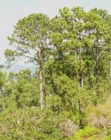Conservation Status

Pinus cubensis
Grisebach 1862
Common names
Pino de Mayarí [Spanish], Cuban pine.
Taxonomic notes
This species shares a sub-clade of section Australes with other species of the southeastern U.S. and Caribbean, including P. caribaea, P. elliottii, P. echinata, P. occidentalis, and P. palustris. The type is from eastern Cuba, C. Wright 598. Synonymy (Farjon and Styles 1997):
- Pinus occidentalis Swartz var. cubensis (Grisebach) Silba 1984;
- Pinus wrightii Engelmann 1880;
- Pinus maestrensis Bisse 1975;
- Pinus occidentalis var. maestrensis (Bisse) Silba 1990.
Various Cuban botanists maintain that Pinus maestrensis is a distinct species. Geada-Lopez et al. (2002), in a plastid DNA analysis of subgenus Pinus, found that P. cubensis and P. maestrensis form a distinct subclade regardless of the molecular data source used in the analysis. Their analysis notes that "Lopez (1982) affirmed that P. cubensis is the older species of Australes in Cuba, while P. maestrensis might have evolved through hybridization between P. cubensis and another species" and that "morphological similarities and sympatry in some areas of the Sierra Maestra between P. cubensis and P. maestrensis have complicated the taxonomy and evolutionary history of these taxa." The plastid haplotype analysis of Jardón-Barbolla et al. (2010) found 11 distinct haplotypes in the two taxa, with the most common 3 haplotypes shared between both taxa (one of these was also shared with P. occidentalis). Based on these lines of evidence, at appears that P. maestrensis might warrant infraspecific or nothospecies status, it has not been so described. Recent authorities (Eckenwalder 2009, Farjon 2010, Debreczy and Racz 2011) do not treat it as a distinct taxon.
Description
Trees to 30 m tall and 100 cm dbh, typically with a single erect trunk and irregularly spreading branches forming a small, open, irregular crown. Bark on mature trees gray-brown, thick, rough, scaly, longitudinally fissured or breaking into irregular, squarish plates. Twigs glaucous to pruinose in the first and second years. Vegetative buds ovoid-oblong; terminal bud 10-15 mm long and lateral buds smaller, acute, not resinous or slightly resinous. Leaves in fascicles of 2(-3), persisting 2-3 years, rigid or flexible, straight or slightly curved, (6-)10-15(-18) cm long, 0.8-1.3 mm thick, acute, light green, occasionally glaucous. Stomata on all leaf faces, with 5-10 lines on the convex abaxial face and 4-5(-7) lines on adaxial face(s). Pollen cones cylindrical, often recurved, 15-20 × 5 mm. Seed cones subterminal, solitary or in pairs, occasionally in whorls of 3-4, on 1-2 cm long, recurved or straight peduncles, deciduous. Mature cones narrow-ovoid when closed, broad-ovoid when opened, 3.5-7 cm long. Seed scales parting readily oblong, straight or slightly recurved, thin woody. Apophyses more or less symmetrical around cone, slightly raised, transversely keeled, transverse-rhombic to pentagonal in outline, with curved or irregular upper margin, up to 11 mm wide, radially striate, dark ochraceous to dull brown. Umbo dorsal, depressed or slightly raised, the minute prickle early deciduous. Seeds obliquely ovoid, flattened, 5-6 × 3-3.5 mm, mottled grey-brown. Seed wings ovate-oblong, 12-16 × 5-6 mm, grey-brown (Farjon 2010).
Distribution and Ecology
E Cuba: Sierra Maestra and Sierra de Nipe, E into the highlands terminating the eastern part of the island, also in foothills and coastal pine barrens at 100-900(-1200) m; climate subtropical, moist (to ca. 1800 mm in the highlands) with a pronounced winter dry season. Typical substrates include serpentine or other ferruginous soils ("Nipe latosol" or "Nipe clay") that yield pine barrens; coastal stands are found on alluvium. It usually forms pure, open stands and is often (as with almost all pines) invasive after disturbance (Farjon and Styles 1997, Farjon 2010). Naturalized in Ecuador.
Distribution data from USGS (1999).
Pinus cubensis is the only pine native to E Cuba (see below); no pines occur naturally between E Cuba and Pinar del Rio at the W end of the island (Farjon and Styles 1997).
Cuban pine forests in eastern Cuba, where this species occurs, are found in small patches around the Sierra del Cristal and Nipe-Sagua-Baracoa Mountains and in the Sierra Maestra. Annual precipitation in this ecoregion somewhat up to 1800 mm, with a dry season from November to April and a rainy season from May to October. Average annual temperature is 25°C, lower at higher elevations. August is the warmest month and January the coldest. The pine forests occur primarily on acid soils with low water retention capacity and few essential elements. The principal soil types are quartz sands, pseudo-spodosols in the west and laterites. P. cubensis is a predominant species in the Sierra Maestra, where it occurs on landslide areas over granitic rock, and in the Sierras del Norte in the east (Nipe-Sagua-Baracoa). Common associates include griñapo (Dracaena cubensis), Eupatorium spp., Myrtus spp., Baccharis spp., Jacaranda arborea, and Eugenia pinetorum (World Wildlife Fund 2008).
Remarkable Specimens
Ethnobotany
As the only native pine within its range, it is locally exploited for its timber (Farjon and Styles 1997).
Observations
Remarks
The epithet refers to Cuba.
Citations
Debreczy, Zsolt and Istvan Racz. 2011. Conifers Around the World. Budapest: Dendropress Ltd.
Eckenwalder, J. E. 2009. Conifers of the World. Timber Press, Portland, OR. 720 p.
Farjon, Aljos. 2010. A Handbook of the World's Conifers. Leiden, Netherlands: Brill Academic Publishers.
Geada López, G., K. Kamiya, and K. Harada. 2002. Phylogenetic relationships of diploxylon pines (Subgenus Pinus) based on plastid sequence data. International Journal of Plant Sciences 163(5):737–747.
Grisebach, A.H.R. 1862. Memoirs of the American Academy of Arts and Sciences 8:530. Available at the Biodiversity Heritage Library, accessed 2011.03.19.
Jardón-Barbolla, L., P. Delgado-Valerio, G. Geada-López, A. Vazquez-Lobo, and D. Pinero. 2010. Phylogeography of Pinus subsection Australes in the Caribbean Basin. Annals of Botany 107(2):229–241.
World Wildlife Fund. 2008. "Cuban pine forests." Encyclopedia of Earth. www.eoearth.org/article/Cuban_pine_forests, accessed 2009.04.10.
See also
Bisse, J. 1988. Árboles de Cuba. Ciudad de la Habana, Cuba: Editorial Científico-Técnica.
Hernandez, J.R. 1989. Atlas de Cuba: mapa de la vegetación original de Cuba. Map 1:2,000,000. Instituto de Geografía de Cuba. Havana, Cuba.
Shaw, G.R. 1904.03.19. The Pines of Cuba. The Gardener's Chronicle 35:179-180. Available at Google Books, accessed 2011.03.19.





